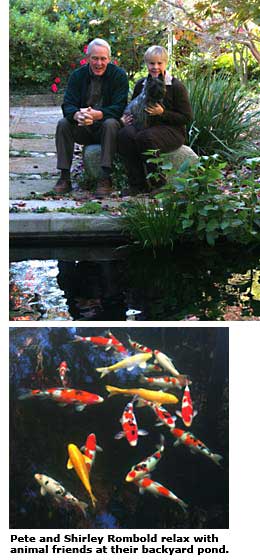Wilhaggin Estates - Sacramento - Page 2
People love the neighborhood's canopy of oaks, red maples, liquid amber, and sycamore trees, plus a variety of palms that thrive in the rich soil of the American River floodplain. The area is a joy for birders, and some Wilhaggin residents, including the Krugers, keep kayaks in their carports. Paddlers spot deer along the banks, and share the river with otters.
Many people also appreciate the neighborhood's architecture. Sparks' 'solution for contemporary living in the Sacramento Valley,' as stated in an original Streng sales brochure, provided open floor plans, plenty of glass, and secluded backyards.
Wilhaggin represents several landmarks in the history of Streng homes. The neighborhood saw the first Streng 'atrium'—a large open area just past the front door, topped by a skylight and ideal for indoor gardening. Unlike the Eichler atrium, the Streng version is not surrounded by glass walls, to avoid turning into a hot box during the Central Valley's hot summers. Wilhaggin also saw the Strengs' only steel-framed home, which came about when a steel frame manufacturer offered free steel studs in an effort to promote their product.

The Strengs and Sparks were always willing to experiment. But they encountered problems with carpenters, who "weren't used to screwing things," Streng says. "They were used to their nails and hammers." Steel studs also made it more difficult to attach wallboard and shelving. And the cost seemed high. "I think maybe we didn't give it an adequate try," Streng concludes.
The neighborhood also has two original Sparks two-story homes. Wilhaggin was also the last Streng neighborhood that included ranch-style homes. Sparks kept his hands pure by not designing them. After Wilhaggin it was all Sparks and all modern.
Wilhaggin remains one of Sparks' greatest creations, its streetscape a remarkable display of how much variety could be obtained from a handful of elements—flat roofs; the wing-like, low-gabled roofs; tall clerestory windows; rafters; broad eaves; courtyards; and skylights. Some of the homes have shallow entry courts. Others have entry courts that are deeper and darker. Some entry courts are topped with skylights or covered with lattices and almost resemble Eichler atriums.
Wilhaggin proved a neighborly place from the start, and remains so today. The Rombolds remember neighborhood potlucks that would move from house to house, with appetizers in the first, dessert in the last. "Sometimes people would be eating in the bathroom, there were so many of us," Shirley Rombold recalls.
Several old-timers used to throw neighborhood Christmas and Fourth of July parties in the Krugers' section of Wilhaggin. Newcomers have recently taken over the task. "It's kind of a transition to the younger generation," Jim Kruger says. Parties always include people from Streng and non-Streng homes. People today regard Wilhaggin—both modern portions and not—as a single neighborhood. It wasn't that way, however, when the Strengs began building. "When we built there," Jim Streng remembers, "the neighborhood did not welcome us."
The wider Wilhaggin neighborhood was already largely developed by 1968, with homes that were generally larger and more expensive than the Streng models, which were selling roughly for $25-32,000. "They were reasonably concerned that our development would devalue the value of their homes," Streng says. Neighbors complained but, Streng says, "There was nothing they could do. Everything we did was according to zoning."

Shirley Nelson and her husband, who had just arrived from Texas, were among Wilhaggin Estate's first buyers, attracted by its proximity to Sacramento State, where her husband taught English, and by its price. "The houses were a little cheaper than the rest of the area," she says. "Wilhaggin was kind of an expensive area even then. We used to say we lived in the poor part of Wilhaggin."
"It was just dirt and prairie and big jack rabbits between us and the river," Nelson remembers. "We had a basset hound back then. He liked to get out and chase the jack rabbits. It was pretty wild territory."
Many original owners taught at Sac State, including Pete Rombold, who appreciated that Wilhaggin was biking distance from the school via a pleasant riverside trail.
Today the American River Parkway, as the bike trail is known, stretches from downtown Sacramento to Folsom Lake, more than 20 miles. Location remains a prime attraction for newcomers. The neighborhood is close to good schools, and not far from downtown entertainment.




